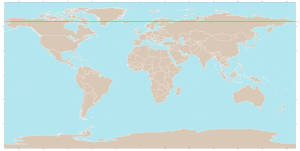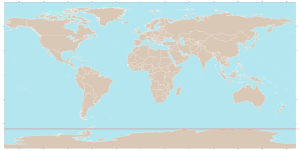Wikipedia:Reference desk/Archives/Science/2019 February 13
| Science desk | ||
|---|---|---|
| < February 12 | << Jan | February | Mar >> | February 14 > |
| Welcome to the Wikipedia Science Reference Desk Archives |
|---|
| The page you are currently viewing is an archive page. While you can leave answers for any questions shown below, please ask new questions on one of the current reference desk pages. |
February 13[edit]
Proper distance along a path (formula dimension ?)[edit]
Hi everybody !
I don't understand the formula on the page about the proper distance along a path P :
where gμν is the metric tensor, and dxμ is the coordinate separation between neighboring events along the path P.
To me, it seems that this is the square root of an interval which already has the dimension of a lenght. So I don't understand the factor in front of the integral. Where am I wrong ?
Thanks for your reply (DVdm ?). Observateur01 (talk) 16:14, 13 February 2019 (UTC)
- @Observateur01: perhaps you overlooked the last paragraph of the section, where the presence of the factor is explained. - DVdm (talk) 16:21, 13 February 2019 (UTC)
- Shame on me ! Thanks DVdm Observateur01 (talk) 16:33, 13 February 2019 (UTC)
- @Observateur01: shame... is what I experience each day. Twice. Even before breakfast
 . - DVdm (talk) 17:35, 13 February 2019 (UTC)
. - DVdm (talk) 17:35, 13 February 2019 (UTC)
- @Observateur01: shame... is what I experience each day. Twice. Even before breakfast
Did the Southern Hemisphere ever have a boreal forest/taiga?[edit]
I've been wondering, for years, if the Southern Hemisphere ever had the kind of boreal forest/taiga present across large swathes of the Southern Hemisphere, like Canada, Russia, and Scandinavia. The closest things that I have found in doing some research, is that there are some alpine forests consisting of Eucalyptus in Australia, some Nothofagus species in New Zealand and southern South America (Chile and Argentina), and a lowland type of "sub polar" forest in Patagonia and Tierra del Fuego consisting of a few NOthofagus species. However, none of these are coniferous proper boreal forests. Digging into research done into the last tree species and forest types in Antarctica itself, I've found that several million years ago, before the continent turned completely to ice, the last forest consisted of scraggly, low growing Nothofagus trees and Podocarpus. However, still no evidence that there was actual boreal forest in the Southern Hemisphere, only ecosystems roughly approximating a boreal forest in the conditions that were present. I ask this question because, I believe, Antarctica itself once had the climatic conditions equivalent to where boreal forests grow today, and presently the alpine environments of New Zealand and southern South America have the right climate to support an alpine conifer forest equivalent to the alpine conifer forests of the northern hemisphere. So we can rule out that climate isn't necessarily an issue, but the right flora to constitute a cold climate conifer forest in the southern hemisphere is instead what is lacking. Thanks in advance if you can point me in the right direction! — Preceding unsigned comment added by 2600:1702:4000:5D40:F446:7F82:C6A9:B110 (talk) 16:45, 13 February 2019 (UTC)
- Because of plate tectonics, various areas of land have not always been where they are now. [Antarctica used to have forests], though I'm not sure if they would be classified as boreal forests, but clearly there used to be wooded areas in what is now Antarctica. One piece in favor of having Boreal Forests in the Southern Hemisphere is that the supercontinent Gondwana used to be centered on the Southern Hemisphere; most of the land on Earth was there, so if there were boreal forests anywhere, they'd have been in the Southern Hemisphere. There could have been; the earliest conifers, the tree we associate with Boreal Forests, evolved on Gondwana about 300 mya, and Gondwana didn't drift and break up until about 200 mya. --Jayron32 17:47, 13 February 2019 (UTC)
- Bunya pine? [on rafts] cygnis insignis 18:27, 13 February 2019 (UTC)
- More likely Athrotaxis cupressoides and Phyllocladus aspleniifolius were more widespread. Graeme Bartlett (talk) 03:07, 14 February 2019 (UTC)
- Also Araucaria araucana, the "monkey puzzle tree" or Chilean pine which formed pine forests in Chile and Argentina, but is now threatened [1] Alansplodge (talk) 12:45, 14 February 2019 (UTC)
|
|
- Some geology surveys claim there is Oil in the Antarctic Circle but there is clearly way more of that in the Arctic Circle. We can see Antarctica is a rather isolated Landmass while the Landmasses in the Arctic Circle are actually the edges of other continents. So the ecology in the Arctic Circle has a withdrawal or backup zone from where to regrow whenever the climate further north fits Boreal Plants and adapted organisms like Lichen while Antarctica was isolated and the typical latitude of a southern Boreal zone has no land but just ocean. So there where probably only a few phases in earth history when Antarctica had enough time to develop some boreal forest zones (that became the few Oil deposites) while in the North there was always a boreal zone that could just move back and forth a latitude according to the climate changes. --Kharon (talk) 05:23, 14 February 2019 (UTC)
- I don't know about this, but reading Gondwana called my attention to Voltziales, and searching those I found this paper about Telemachus (sorry no, that's not an article on the plant and we don't have one). Searching that pulled up this reference about global warming from the Permian to Triassic causing the disappearance of mire forests. I must admit I hadn't heard of mire forests but apparently they can be in a gradient with boreal forests. [2] Apparently mire forests exist in New Zealand now, [3] but searching for boreal forests in New Zealand or any forests in the New Zealand Subantarctic Islands just gets "rata forest" that is lovely and doesn't look remotely boreal. Argument can be made that any such forest is an austral forest anyway, just like the Southern Lights, but that's kind of semantic. ;) In short I still don't know about this but I hope these links can be useful for further searching. Wnt (talk) 14:50, 14 February 2019 (UTC)
- Just found much more detailed articles about the question: Geology of Antarctica, Polar forests of the Cretaceous and South Polar region of the Cretaceous. --Kharon (talk) 04:35, 15 February 2019 (UTC)
Detecting sources of wave function collapse[edit]
The above discussion is very interesting and I particularly enjoyed @Dragons flight:'s response and would love to see a link to the thought experiment @Count Iblis: mentioned, but we need a new topic, having strayed too far from the old one. What I'm wondering is whether there have been proposals for any device capable of mapping the source of a wave function collapse. Warning: the following probably contains dozens of grievous errors...
For example, I'm daydreaming of a rudimentary quantum computer that takes a |0> state, implements the Hadamard quantum logic gate (turns it to a 50-50 superposition), then "measures" the result in a way that is questionably a measurement, before doing another Hadamard operation and seeing if the result is reliably 1. What I want is a "measurement" that stores the result in a pair of entangled photons of opposite circular polarization, so that if they both impinge on the same target at the same time, the angular momentum cancels out, the information is lost and no "measurement" occurs ... I think. If they strike near each other then maybe no information is retained?
I'm not sure if this would violate the no-cloning theorem. The photons would have probability according to the quantum state, however it would be according to the real number probability only, not the complex value of the state, so I'm thinking not. Yet if it were permissible, would it permit backward communication in time, since who knows if the photons' data will be lost? (The processor counting the |1>'s...) But if it doesn't work then why not, what are the limits? What makes a measurement a measurement? Wnt (talk) 23:58, 13 February 2019 (UTC)
- This looks a bit like Wheeler's delayed choice quantum eraser experiment, there the which way information can be erased after the photon passes through the slits. Also note that you can do a suitable measurement on single photons after they pass through the slits instead of letting them collide with the screen to determine in a single measurement whether or not there would be an interference pattern on a screen (which would have taken many photons to see). Count Iblis (talk) 07:03, 14 February 2019 (UTC)
Web searches on "speed of decoherence" might cast some light (or more confusion) on this question. 173.228.123.166 (talk) 09:43, 19 February 2019 (UTC)





